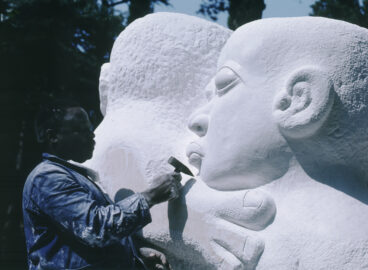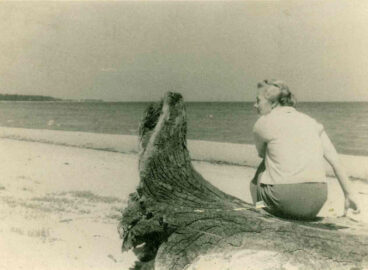A major new publication, Art and Theory of Post-1989 Central and Eastern Europe: A Critical Anthology, presents key voices of this period that have been reevaluating the significance of the socialist legacy, making it an indispensable read on modern and contemporary art and theory. The publication offers a rich collection of texts and an additional, reexamining perspective to its 2002 sister publication, A Sourcebook for Eastern and Central European Art since the 1950s, part of MoMA Primary Documents publications. For this new book, a series of conversations were commissioned with artists in the region and members of the C-MAP research group for Central and Eastern Europe at MoMA. The following is one of those dialogues, between MoMA curator Paulina Pobocha and artist Artur Żmijewski.
Read a review of the publication at Hyperallergic.

Paulina Pobocha: The outset of your career coincided with the fall of communism and Poland’s embrace of democracy thereafter. Could you reflect on the first years of a democratic Poland and the effect this context had on your work, which from its beginning has deployed and interrogated social relations as subject matter?
Artur Żmijewski: The fall of communism was not “the beginning of democracy” in Poland—it was the beginning of the brutal fight between political forces that wanted to define what democracy is. Each of these forces wanted to define the constitutional system, economic system, system of political exchange, and the system of dominant moral values. Artists and other culture workers wanted to take part in this early process of “programming” the country. So artists who for the first time were able to speak with open voices started to be disciplined according to dominant moral strictures—by the media and by politicians [who were allied with Catholic fundamentalists]. I used this freedom of speech, which at the time was still being debated rather than controlled. We have a slightly different situation today [ever since the rightwing Law and Justice Party assumed power in 2015]—mainstream politicians try to control culture, as they try to control the entire field where politics, culture, science, religion, and so on operate as “autonomous” entities. There was a leftist idea that everything is political, so everything can be debated. This idea was stolen by the populists, but they changed the meaning of politics itself: it’s not a debate anymore, it’s control and punishment. So if everything is political, everything should be controlled.
PP: When did you become interested in manifesting your own political views?
AZ: It was an evolution. There wasn’t one single moment when I started to think I wanted to be viewed politically. Of course, I was interested in politics, because of this special period of time in which I started my career, after the Wall and immediately after the collapse of the communist system in Poland. I was witness to all these changes.
PP: You have often attempted to show these changes in your work, in your movie Them [2007], for example.
AZ: There was a growing political fever, if you will, during the post-Soviet transformations in Poland and elsewhere; mainstream politicians had ample opportunity to vent their heated views, but that was not the case for many ordinary people. So I made a movie, Them, in which four groups of radicals fight together on a symbolic battlefield, where they are able to show all their roiling emotions while clarifying and polishing their political views.
PP: You also decided to present your own political views—was that difficult?
AZ: It was not easy to declare, as an artist, my own political views. The general understanding was that artists should be apolitical; they shouldn’t talk about politics because it’s dirty and it’s busy with temporal problems, which will disappear in a moment or be replaced by other problems. Artists should be dealing instead with eternal themes—love, death, the human condition. There was a certain shame in saying, “I’m very much interested in politics. Maybe politics is even more important than art. It’s a social discourse that creates a field to discuss all other issues, or it’s manipulated to block such a discussion.” Sławek Sierakowski, the head of [the leftwing group] Krytyka Polityczna [Political Critique] really supported me, because there were no other people who were ready to support me in such a declaration that, yes, politics should be a topic for art. The artist is also a political actor. Art institutions play political games and can be a political force, a place for debate.
PP: In 2006 you published the essay “The Applied Social Arts,” which advocates for an art capable of social impact. Was the essay prompted by any particular shifts you detected in the sociopolitical landscape of Poland at the time, or in the art that was then being made?
AZ: Around 2005, I became more firmly committed to the idea that art can effectively concern itself with political problems. I was invited by Sławek Sierakowski to write an essay about it. I had met Sławek a few months before in the small city of Łagowo during its film festival—it was not a celebrity-style festival; it was a laboratory of filmmakers. We started to talk about political issues. He found out that I’m interested in this topic; I found out that it’s interesting for me to talk to him about politics. It was a telling moment for me. I developed the idea of political involvement after that. Art was used in the past by politicians for their ideological fight because culture/art can be very influential. Art “manipulates” emotions; it’s not rational discourse—it has a much more direct impact than rationality. The alternative idea could be that artists and cultural institutions themselves decide the potential political use of art’s authority.
PP: Your essay was met with criticism. The commingling of art and politics, or art and political activism, sometimes creates discomfort. In Poland and elsewhere in the broader region, there is a very specific history of art being deployed for political purposes by the state. Of course, there are also many rich traditions of political art being made to critique the dominant power—art of resistance—which is political by nature and difficult to co-opt.
AZ: Yes, here in Eastern Europe there is the memory of art as propaganda. Art and artists were used by the state to convert people into followers of the communist ideology, to trust the new rulers of the Eastern bloc and their inhumane regimes in the ’50s,’60s, and later on. It was exactly the issue taken up in “The Applied Social Arts”: – Art could be “used” as a political tool, but the obstacle to doing so is the shame from the past when art lost its freedom and was transformed into propaganda; – the awareness of this shame could, in fact, allow artists take the step forward and use their art as a political tool again (if some of them want to, of course); – the autonomy of the artist could be instrumentalized this time by the artists themselves, not by the state regimes; – the essay also presented a wish to make possible art activity that could generate visible social effects—so, from aesthetic forms to real results.
PP: What you say implicitly brings to the fore the critical differences between the democratic system and the totalitarian regime that it replaced, and it suggests the difficulties for artists and others to pass from one to the other and to do so in a compressed period of time—in our case, let’s say the decade of the 1990s—a timeframe that may not allow for coming to terms with the “shame of the past,” as you say. In that case, “The Applied Social Arts” may have reached an audience not ready for its content. Could you speak to the role of art institutions in this exchange?
AZ: It’s much easier for individual artists to make decisions about their political roles than for art institutions. People who work in institutions, which in fact carry a lot of influence, prefer to avoid political involvement and political responsibility. They reduce things to the basic level that, “We educate society, but we don’t play any political role. We don’t support any political view: we are not liberals, not socialists, not leftists, and not rightists. We are purely apolitical.” Being apolitical became the political stand of the art institutions.
PP: Is this due to how art institutions in Poland are funded?
AZ: Institutions depend on state funds. Also, a conservative model of museums and art institutions dominates—I mean, the idea that a museum should be reduced to collecting and presenting different phenomena. The art institution is allowed to present art about politics, but not to be involved in political acts. In Poland, the art historian Piotr Piotrowski had an idea for the National Museum in Warsaw to be an entity involved in current political debates. The name for such an institution would be Critical Museum. When he was the director of the National Museum, he made a statement in the form of big show about gay and lesbian life and culture, a manifestation of his idea that the institution could be politically involved. Unfortunately, he was fired by the advisory board of the museum. So it’s possible to find examples of the political involvement of art institutions and museums, even if they are financed by state money, even if they depend on the Ministry of Culture or they receive money from the local government. Piotrowski’s concept showed that it’s possible to transform a conservative museum of fine art into an active player in political debate in the country, though Piotrowski paid a price for it.
PP: The Berlin Biennale you organized took place in 2012. In the years since, and within Poland, would you say the reluctance of artists to engage politically continues? Or is there more engagement?
AZ: Not really. In Poland, people are afraid that the government’s cultural policy will be similar to Hungary, where Viktor Orbán has transformed important museums, such as the Ludwig Museum or Műcsarnok, into unimportant institutions.
While people are politicized nowadays, they still don’t know how to protect themselves, how to use the power they have, the institutional power. They don’t know how to use all this capital, and all the resources they have to conduct political activity. They would rather try to adapt then resist. Even if they are different [than during the communist era], even if they are much more aware of their rights, of the political situation, political rioting, political brutality, still there is a certain passivity, and people don’t know how to act.
PP: As the situation gets worse, it would seem there’s more incentive to act politically.
AZ: We have all these rightwing populists becoming prime ministers and presidents. In many countries, and in important countries like the U.S., people are in quite similar situations. In next few years, when the crises will be deeper and the political situation much more difficult, people will try to develop strategies of resistance, or maybe strategies of doing something effective to counter this situation, but they may not be able to. There are not many good strategies of resistance now; the only working strategy at the moment is to mount big protests. But even if you present your power, politicians who behave like desperados will continue to behave like desperados, even if the only horizon is a cul-de-sac. It looks like they love hazardous games. I think that the only way is to create a political party and start to confront the social and political situation directly. But that is a life’s project, and we don’t have an alternative life. I’d like somehow to reduce the “quantity” of politics in my life, and in human life in general.


